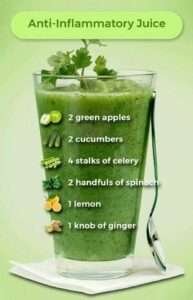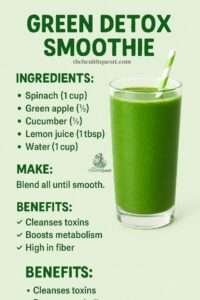Green Detox Juice With Kale, Cucumber, and Apple is a simple, refreshing blend that helps cleanse your body, hydrate your cells, and support digestion. Packed with nutrients, this recipe offers a natural way to boost energy, reduce bloating, and get more greens into your day.
Green Detox Juice With Kale, Cucumber, And Apple
This juice combines nutrient-dense kale, hydrating cucumber, and naturally sweet apple to create a bright, refreshing drink you can enjoy any time of day. You’ll find this recipe simple to make, easy to customize, and supportive of general wellness when consumed as part of a balanced diet.
Why this juice works
This combination balances greens, hydration, and natural sweetness so the flavor is pleasant while the nutrients remain potent. You’ll benefit from vitamins, minerals, and phytonutrients with every glass, and the mild flavor profile makes it suitable for most palates.
Kale: nutrient powerhouse
Kale is rich in vitamins A, C, and K, along with minerals like calcium and potassium, and numerous antioxidants that protect cells from oxidative stress. When you include kale in a juice, you tap into concentrated nutrients that support immune function, bone health, and inflammation control.
Cucumber: hydration and alkalinity
Cucumber is mostly water, which helps you stay hydrated while providing silica and small amounts of vitamins and minerals. Its mild flavor also helps mellow the intensity of raw greens, making your juice more refreshing and easy to drink.
Apple: natural sweetness and fiber
Apple adds natural sweetness and a pleasant aroma that balances the bitterness of kale and the freshness of cucumber. You’ll also receive pectin and soluble fiber if you use a high-speed blender or include some pulp, which supports healthy digestion and stabilizes blood sugar when combined with other ingredients.
Ingredients
Below is a clear list of the ingredients you’ll need, with recommended quantities for one large serving or two small servings. You can adjust any amount to match your taste and nutritional goals.
| Ingredient | Amount (single serving) | Purpose |
|---|---|---|
| Kale (washed, large stems removed) | 2 cups packed | Primary green, vitamins and antioxidants |
| Cucumber (medium, unpeeled) | 1 whole | Hydration, mild flavor, minerals |
| Apple (medium, cored; any variety) | 1 whole | Sweetness, flavor, phytonutrients |
| Lemon (optional; juiced) | 1/2 | Brightness, vitamin C, flavor balance |
| Fresh ginger (optional) | 1/2 inch piece | Anti-inflammatory spice, warmth |
| Water (for blender method or to dilute) | 1/2 to 1 cup | Adjust texture and concentration |
| Ice (optional) | As desired | Chilled serving |
You can increase ingredient amounts proportionally if you’re making more servings. Organic produce reduces pesticide exposure but isn’t required.
Equipment you’ll need
Choose equipment that matches your preferred method: a juicer yields clear juice without pulp, and a blender keeps the fiber. You’ll only need a few basic tools to make this juice.
| Equipment | Use |
|---|---|
| Juicer (centrifugal or masticating) | Produces smooth juice, minimal pulp |
| High-speed blender | Keeps fiber, more filling texture |
| Fine mesh strainer or nut milk bag | Optional for straining blended juice |
| Sharp knife and cutting board | For prepping produce |
| Measuring cups and spoons | For precise optional ingredients |
| Glass bottle or jar with lid | For storing juice |
Both methods are quick. If you want more texture and fullness, use a blender; if you prefer a clear juice, use a juicer.
Step-by-step recipe
Below are detailed instructions for both juicing and blending methods, plus tips for preparation and serving. You’ll find step-by-step guidance so you can make this juice confidently.
Preparation
Wash and prep all ingredients to remove dirt and residues, and remove large kale stems so your texture stays pleasant. Core the apple and chop the cucumber into pieces small enough for your machine.
- Wash kale thoroughly, especially if it’s not pre-washed.
- Slice the cucumber and apple to fit the feeding chute of your juicer or blender.
- If using ginger or lemon, peel and measure them before adding.
These small prep steps save time and ensure a consistent result every time.
Using a juicer
Feed kale, cucumber, and apple through the juicer, alternating ingredients to help the machine process leafy greens easily. Start with a cucumber chunk, then a handful of kale, and then apple slices, repeating until all ingredients are juiced.
- If your juicer struggles with leafy greens, roll the kale into a tight bundle before feeding it.
- Add lemon juice at the end for a bright finish.
- If you prefer slightly diluted juice, stir in a splash of cold water.
Juicing yields a clear, smooth liquid that’s easy to drink quickly or sip slowly throughout the morning.
Using a blender
Place chopped cucumber, apple, kale, lemon juice, and a small amount of water into the blender jar. Blend on high until the mixture is smooth, then taste and adjust sweetness or acidity.
- For a thinner consistency, add 1/4 to 1/2 cup water and blend again.
- If you want a clearer juice, pour the blended mixture through a fine-mesh strainer or nut milk bag to separate the pulp.
- Save leftover pulp for baking, composting, or adding to smoothies for extra fiber.
Blended juice keeps the fiber, which helps you feel fuller and slows carbohydrate absorption.
Serving and garnish
Pour the juice into a tall glass and add ice if desired for a chilled beverage. Garnish with a lemon wheel or a small sprig of fresh mint for aroma.
- Consume fresh juice within a short window for best flavor and nutrient retention.
- If you plan to store the juice, use airtight glass containers and keep refrigerated.
These presentation touches make the juice feel special and increase your enjoyment.
Juicer vs Blender: pros and cons
Choosing between a juicer and a blender depends on what you value most: clarity or fiber, speed or fullness. This table summarizes the main differences to help you choose.
| Feature | Juicer | Blender |
|---|---|---|
| Texture | Clear, smooth juice | Thick, smoothie-like with pulp |
| Fiber retention | Mostly removed | Retained, unless strained |
| Satiety | Less filling | More filling due to fiber |
| Nutrient absorption | Faster absorption of liquid nutrients | Slower absorption, sustained release |
| Prep and cleanup | Often a bit more cleanup | Usually faster cleanup |
| Best for | Quick, light detox juices | Meal-replacement style drinks |
Both devices produce healthy beverages, so pick the one that best fits your routine and preferences.
Nutrition estimates per serving
Below is an approximate nutrition breakdown for one large serving made with the ingredients listed earlier (2 cups kale, 1 cucumber, 1 medium apple, 1/2 lemon). Exact values vary by produce size and variety.
| Nutrient | Approximate Amount |
|---|---|
| Calories | 140–200 kcal |
| Carbohydrates | 30–40 g |
| Fiber | 4–8 g (higher if blended and unstrained) |
| Sugars (natural) | 18–25 g |
| Protein | 3–5 g |
| Fat | 0.5–1 g |
| Vitamin C | 50–80 mg (provides a substantial portion of daily need) |
| Vitamin K | 200–400 µg (kale is very high) |
| Potassium | 600–900 mg |
| Calcium | 80–150 mg |
| Iron | 1.5–3 mg |
These are estimates; using a nutritional calculator with exact ingredient weights will give more precise results. Keep in mind that juicing removes some fiber but can concentrate certain vitamins and minerals.
Health benefits in detail
Understanding how this juice supports your health can help you make informed choices about when and how to include it in your routine. Below are the primary benefits and how they apply to you.
Hydration and electrolyte support
Cucumber contributes high water content and electrolytes that help maintain fluid balance and support physical performance. Drinking this juice can be a pleasant way to add hydration between meals or after light activity.
Antioxidants and anti-inflammatory effects
Kale and apple supply various antioxidants like vitamin C, beta-carotene, quercetin, and flavonoids that help neutralize free radicals. Regular intake of antioxidant-rich foods helps reduce markers of chronic inflammation over time.
Fiber and digestion
If you use a blender or retain pulp, you get fiber that supports healthy bowel movements, fosters beneficial gut bacteria, and improves satiety. Even when juiced, some soluble fiber and polyphenols remain, offering digestive benefits.
Blood sugar and weight management
Apple provides natural sugars, but when combined with kale’s fiber and cucumber’s low glycemic load, the glycemic impact is moderated. If you’re managing blood sugar or attempting weight loss, pair the juice with protein or a high-fiber snack to stabilize glucose levels and extend fullness.
When to drink and how much
You can enjoy this juice at various times depending on your goals, and frequency should reflect your overall diet and medical needs. Moderation and context matter when using juices as part of a healthy plan.
- Morning: A great on-the-go option to start the day with vitamins and a light boost of energy. Consider pairing it with a protein source if you need sustained energy.
- Pre/post-workout: The juice provides hydration and quick carbohydrates for light exercise, and the antioxidants aid recovery.
- As a snack: A small glass can replace less-nutritious snacks if you need a low-calorie, nutrient-rich option.
Aim for one serving per day if you’re incorporating it as part of a varied diet, and consult your healthcare provider if you have specific conditions that require monitoring of vitamins or sugars.
Customizations and variations
This recipe is flexible, and you can tailor it to your taste, nutritional needs, and what’s in season. Below are categories of add-ins and swaps to consider.
For extra sweetness
If you prefer a sweeter profile, add half a ripe pear, a small banana (best with a blender), or a tablespoon of maple syrup or honey. These options raise natural sugars, so reduce portions elsewhere if that’s a concern.
For more greens
Add spinach, Swiss chard, or a few sprigs of parsley to increase chlorophyll and minerals without drastically changing flavor. Rotate greens to broaden your nutrient intake and avoid monotony.
For spice and digestion
Increase the ginger to a full inch or add a pinch of cayenne for a metabolism-boosting kick. Turmeric (fresh or powdered) pairs well with a squeeze of black pepper to enhance curcumin absorption, offering anti-inflammatory benefits.
For creaminess and protein
Blend with a scoop of plant-based protein powder, a tablespoon of chia seeds, or half an avocado for a more filling beverage. These additions turn the juice into a light meal replacement that supports longer satiety.
Substitutions table
If you don’t have an ingredient or want a different profile, use these simple swaps.
| Original | Substitute | Effect on flavor/nutrients |
|---|---|---|
| Kale | Spinach, Swiss chard, collard greens | Mild change in bitterness; similar nutrients |
| Cucumber | Celery, zucchini | Similar hydration; celery adds more sodium and flavor |
| Apple | Pear, green grapes | Similar sweetness; pear softer if blending |
| Lemon | Lime, splash of apple cider vinegar | Similar acidity; vinegar adds tang and shelf life |
| Ginger | Turmeric or mint | Different health focus; turmeric = anti-inflammatory, mint = cooling |
These swaps keep the core idea intact while adding variety.
Storage and shelf life
Fresh juice is best consumed immediately, but you can store it for short periods with care. Proper storage preserves flavor and slows nutrient loss.
- Refrigerator: Store juice in airtight glass containers and fill them to the top to minimize oxidation. Consume within 24–48 hours for best quality.
- Freezing: Pour juice into freezer-safe containers leaving headspace, then thaw in the fridge overnight and shake well before drinking. Some texture and nutrient loss occurs with freezing.
- Avoid metal lids in prolonged storage, as acid in the juice can react with metal over time.
Label containers with the date so you know how fresh the juice is and avoid drinking anything that smells off or tastes sour.
Safety, possible side effects, and interactions
While this juice is generally safe for most people, there are a few considerations to keep in mind to protect your health.
Vitamin K and blood thinners
Kale is high in vitamin K, which plays a role in blood clotting and may interfere with anticoagulant medications like warfarin. If you take blood thinners, consult your healthcare provider to determine safe intake levels and maintain consistent vitamin K consumption.
Oxalates and kidney stones
Greens like kale contain oxalates, which in susceptible individuals can contribute to kidney stone formation. If you have a history of oxalate stones, talk to your doctor or dietitian about portion sizes and alternatives.
Sugar content and diabetes
Apples add natural sugars, so if you manage diabetes, watch portion size and pair the juice with protein or fat to blunt glucose spikes. Consider blending with less fruit and more greens, or choose a lower-sugar fruit like berries as an alternative.
Gastrointestinal sensitivity
Some people may experience bloating or gas when consuming concentrated raw green juices, especially if they’re unaccustomed to large quantities of raw greens. Start with smaller servings and increase slowly to allow your digestive system to adapt.
Juice versus whole food: benefits and trade-offs
Both juice and whole-food forms of these ingredients are valuable, and understanding the differences helps you make better choices for your lifestyle.
- Juice: Provides a fast, concentrated dose of vitamins, minerals, and phytonutrients; easier to consume when you’re busy or have low appetite. It removes much of the insoluble fiber, which can reduce satiety and alter blood sugar response.
- Whole food: Keeps full fiber content, promoting strong satiety and slower carbohydrate absorption while providing the same vitamins in a less concentrated form. Whole fruits and vegetables also offer chewing-related benefits and more sustained energy release.
Use juice as a supplement to, not a replacement for, whole fruits and vegetables in your overall diet.
Troubleshooting common problems
If your juice doesn’t taste right or your equipment causes issues, these fixes will get you back on track. Below is a quick reference for common problems and solutions.
| Problem | Likely cause | Fix |
|---|---|---|
| Bitter or overly strong flavor | Too much kale or insufficient sweetener | Add apple or pear, or reduce kale proportion |
| Pulpy or grainy texture | Blender not fully breaking down fibers | Add extra liquid and blend longer; strain if desired |
| Juice separates quickly | Natural separation after blending | Shake or stir before drinking; consume fresh |
| Juicer clogs on greens | Feeding too many leafy greens at once | Alternate with harder produce (apple, cucumber) |
| Metallic taste after storage | Reaction with metal lid or container | Use glass containers and plastic-free lids |
These small adjustments often solve the most common issues.
Frequently Asked Questions
Below are answers to questions people commonly ask about this type of juice. They’ll help you make informed, practical choices.
Q: Can I drink this juice every day? A: You can drink it daily if it fits within your overall diet and you don’t have health conditions that require limiting vitamin K or oxalates. Varying the greens and fruits you use will help prevent nutrient excess and keep things interesting.
Q: Is it better to juice or blend? A: Both methods have advantages: juice is lighter and often more palatable for people who dislike leafy textures; blended drinks keep fiber and are more filling. Choose based on your goals—quick nutrient boost versus a satiating mini-meal.
Q: How long before nutrients degrade? A: Some vitamins, like vitamin C, begin to degrade soon after juicing, so flavor and nutrient potency are best within 24–48 hours when stored cold in airtight containers. Fresh consumption yields the highest nutrient availability.
Q: Can children drink this juice? A: Children can enjoy it in smaller portions, especially if suitably sweetened with apple or pear to make it more appealing. Avoid serving large quantities to very young children due to high vitamin K content and natural sugars; consult your pediatrician for guidance.
Q: Can this juice help with detoxification? A: While your body naturally detoxifies via liver, kidneys, lungs, and skin, a nutrient-rich juice supports those systems by supplying antioxidants, hydration, and vitamins. Don’t rely on juice alone for cleansing—prioritize a balanced diet, sleep, and activity.
Q: Will juicing remove all fiber? A: Juicing removes most insoluble fiber but retains some soluble components and phytonutrients. If you want the fiber benefits, use a blender and retain the pulp or incorporate leftover pulp into other recipes.
Q: How can I reduce bitterness? A: Add sweeter fruits (apple, pear) or a splash of citrus juice to balance bitterness. A small piece of ginger can also enhance flavor while masking some green notes.
Q: Is organic produce necessary? A: Organic reduces pesticide residues but is not required. Prioritize organic for produce where you’re most concerned about pesticide exposure (often called the “dirty dozen”) if you’re able.
Final tips and serving suggestions
Serve your green detox juice chilled in a clear glass so you can appreciate its color and freshness, and pair it with a protein-rich breakfast or a handful of nuts for balanced energy. Keep notes on how certain tweaks affect your energy, digestion, and taste preferences so you can refine the recipe to fit your routine.
By making this Green Detox Juice with Kale, Cucumber, and Apple a part of your toolbox for nutritional support, you’ll have a convenient, tasty option for adding more vegetables and hydration to your day. Try small modifications to find the exact balance you enjoy, and let the juice complement—rather than replace—balanced, whole-food meals.


